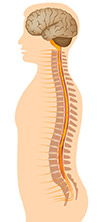Spinal Injections have Proven to be an Effective Option for Managing Spine Conditions
Injections are used to reduce pain, increase mobility and avoid or delay the need for surgery.
Epidural Steroid Injection (ESI)
An epidural steroid Injection (ESI) is an outpatient procedure in which a steroid
(an anti-inflammatory medicine)
is injected into a very precise area of the epidural space of the spine,
using continuous X-ray guidance (fluoroscopy).
For comprehensive information about your injection at our Spine Center, read All About Your Spinal Injection (PDF).
Watch: Spinal Injection Video Series
Please be sure to discuss all questions and concerns about epidural steroid injections and your spine care with your doctor.
Benefits of ESI
Relieves Pain
ESI relieves pain in the arms and legs caused by an irritated nerve root.
Reduces Inflammation
ESI is used to reduce any inflammation that may be present in a spinal
nerve root.
Helps Determine Cause of Symptoms
ESI is useful in both the diagnosis and treatment of certain spine
conditions. By placing the medication in a precise area and monitoring the
patient's response, valuable information is gained about what nerves may or
may not be involved in causing the symptoms, and how to target appropriate
treatment for pain relief.
What to Expect During an ESI
-
The patient will lie face down on a table.
-
Numbing medicine will be injected into the patient's back.
-
Contrast dye will be injected into the area so that the structures of
the spine will be visible on X-ray.
-
Using X-ray guidance, the doctor then places the steroid medication
into the precise area of the patient's back believed to be causing the
problem.
An epidural steroid injection takes about 15 minutes. The patient is then
observed for 20 to 30 minutes before going home. The arms or legs can be
weak immediately after the procedure because of the numbing medication, so
patients are asked not to drive themselves home and to take care when
moving about for the rest of the day.
How Long Does ESI work?
-
Many patients who undergo ESI have a significant decrease in arm or leg
pain.
-
It can take a few days for the effects of a spinal ESI to be known;
however, if the pain gets better, the effects usually last about six to
12 weeks.
-
If needed, an ESI can be repeated. Patients who do get better may not
experience complete pain relief; a realistic goal is to achieve a major
reduction in the level of pain.
Common Misconceptions About ESI
Frequency
There is no maximum number of ESI treatments. Some patients get relief
after one or two treatments, others need additional injections. Your doctor
will discuss with you how many treatments you may need.
ESI vs. Epidural Anesthesia
An epidural steroid injection is not the same thing as
epidural anesthesia used during childbirth or certain surgeries.
An ESI does not involve multiple needle sticks to the
back. Unlike epidural anesthesia, ESI is done under X-ray guidance,
allowing the doctor to see exactly where to place the injection, which
eliminates the need for multiple sticks.
Headaches and other complications sometimes seen with epidural anesthesia
are rare following ESI.
Transforanimal ESIs
A transforaminal epidural steroid injection (ESI) is an
advanced technique for spinal injections, in which medication is given to a
very specific area of the spine.
Advantages of Transforaminal ESI
Reducing Pain
Transforaminal ESI may better the chances of reducing a patient's arm or
leg pain that is caused by nerve problem in the spinal column. The main
advantage of transforaminal ESI is that the doctor can deliver the medicine
into the neural foramen that contains the actual nerve root in question,
which can increase the likelihood of successfully reducing the patient's
back pain.
Ensures Focus on Correct Nerves
 Another advantage of transforaminal ESI is that the doctor can also inject
lidocaine — a numbing medication — that works immediately (but temporarily)
to numb the nerve root. If the numbing medication immediately relieves the
patient's pain, the physician then knows that the correct area of the spine
has been reached. This can help ensure that additional steroid injections
or potential surgery focus on the correct nerves.
Another advantage of transforaminal ESI is that the doctor can also inject
lidocaine — a numbing medication — that works immediately (but temporarily)
to numb the nerve root. If the numbing medication immediately relieves the
patient's pain, the physician then knows that the correct area of the spine
has been reached. This can help ensure that additional steroid injections
or potential surgery focus on the correct nerves.
Considerations
Spine injections should only be done by doctors with special training.
Before the ESI procedure, the doctor will get detailed pictures of the
spine using MRI or CT scan, which will help determine the best approach.
What to Expect During a Transforaminal ESI
-
The patient will lie face down on a table.
-
Numbing medicine will be injected into the patient's back.
-
Contrast dye will be injected into the area so that the structures of
the spine will be visible on X-ray.
-
Using X-ray guidance, the doctor then places the steroid medication
into the precise area of the patient's back believed to be causing the
problem.
The transforaminal ESI takes about 15 minutes. The patient is then observed
for 20 to 30 minutes before going home. The arms or legs can be weak for a
brief time after the procedure because of the numbing medication, so
patients are asked not to drive themselves home and to take care when
moving about for the rest of the day.
Patients may have slight discomfort for a few days after the injection,
before they begin to feel the benefits of pain relief.
How Long Does ESI work?
-
Many patients who undergo ESI have a significant decrease in arm or leg
pain.
-
It can take a few days for the effects of a spinal ESI to be known;
however, if the pain gets better, the effects usually last about six to
12 weeks.
-
If needed, an ESI can be repeated. Patients who do get better may not
experience complete pain relief; a realistic goal is to achieve a major
reduction in the level of pain.
Spine Anatomy
Vertebrae
 Your spine is made of ring-shaped bones called vertebrae.
Your spine is made of ring-shaped bones called vertebrae.
Spinal Column
The "rings" at the center of each vertebrae line up to form a column in
your back, the spinal column.
Spinal Cord
The spinal cord extends from the base of the brain and
ends at the upper lumbar spine, continuing further down as a large bundle
of nerves through the lower part of the spinal column.
Dura Mater
A membrane called the dura mater covers and protects the
spinal cord.
Epidural Space
The small area surrounding the dura mater is called the epidural space.
Nerve Roots
Branches of nerves from the spinal column (nerve roots)
pass through the spinal canal and extend into the back, arms, and legs. If
something is irritating the nerve roots (such as an abnormality in one of
the vertebrae or discs), pain can be felt in the back and all along the
nerve.

 Another advantage of transforaminal ESI is that the doctor can also inject
lidocaine — a numbing medication — that works immediately (but temporarily)
to numb the nerve root. If the numbing medication immediately relieves the
patient's pain, the physician then knows that the correct area of the spine
has been reached. This can help ensure that additional steroid injections
or potential surgery focus on the correct nerves.
Another advantage of transforaminal ESI is that the doctor can also inject
lidocaine — a numbing medication — that works immediately (but temporarily)
to numb the nerve root. If the numbing medication immediately relieves the
patient's pain, the physician then knows that the correct area of the spine
has been reached. This can help ensure that additional steroid injections
or potential surgery focus on the correct nerves.
 Your spine is made of ring-shaped bones called vertebrae.
Your spine is made of ring-shaped bones called vertebrae.